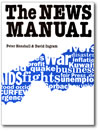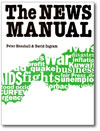Volume 1 : Basic Techniques |
Volume 2 : Advanced Reporting |
Volume 3 : Ethics & The Law |
|
 |
 |
A sequence of skills
‘The News Manual’ is structured to help you build your skills in a logical and natural way. The following is a brief explanation of what to expect.
Chapters 1 to 24 – Basic techniques
In the first third of ‘The News Manual’ we concentrate on the basic skills of journalism. We start with a chapter describing in simple terms what news is, then take you step-by-step through the process of structuring and writing a news story. We give guidance on writing styles for journalism and the correct ways of presenting what you have written. Finally we introduce basic reporting skills such as interviewing and reporting speeches, skills which every good journalist needs.
The first six chapters are the most important for journalists new to the profession. Spend some time on them. Read them thoroughly - several times if necessary - until you are confident that you can recognise a possible news story and then write it in a simple straightforward style. The best way to learn any skill is through practice, so take every opportunity you can to write news stories. Write and write and write again until your skills are as sharp as a razor.
Chapters 7 to 15 cover the basic techniques of researching and presenting news while Chapters 16 to 24 cover basic reporting skills, which you must practise too. They lay the foundations for most reporting tasks you are likely to encounter as a journalist.
Chapters 25 to 55 – Advanced techniques
These chapters build on the basic techniques of journalism which we looked at in Chapters 1 to 24. They look at more advanced reporting skills, and how they are applied in a number of special areas of life.
The specialist reporting of certain areas of life is called rounds reporting. Chapter 26 is therefore an introduction to rounds reporting and how to do it well.
Chapters 27 to 38 look in detail at six rounds which make special demands on reporters: politics, industry & finance, science & technology, religion, minorities and crime.
Chapters 39 to 45 deal with special kinds of journalism to handle special situations. We look at investigative reporting, how to handle stories of death and disaster, and how to handle stories which are happening as you report them - breaking stories.
Chapters 46 to 49 are specific to particular media - news pictures, for print media; and writing for radio and television, for broadcast media.
Because newspapers and news bulletins do not only contain news, in Chapters 50 to 55 we look at some of the other areas which journalists have to cover - features, obituaries, reviewing of arts and other creative activity, and sport. |
Looking for something?
A quick way to find what you're looking for in The News Manual is through the Index. It has more than 1,000 links to concepts throughout the manuals. Click here:

|
Chapters 56 to 73 – Ethics and law
In these chapters we look at the major ethical issues in journalism and at the laws which will probably affect the way you work.
Chapters 56 to 62 are on ethics and the final nine chapters of this guide are on law. The two are not quite the same. Ethics is the consideration of what is right and wrong; laws are statements of what is permitted and not permitted.
Ethics and law are the two basic forces which govern the way people behave in societies. They are usually consistent on issues, because most societies prefer to have laws which are based on an accepted body of ethics. However, this is not so in all cases. Laws can allow behaviour which is unethical or prohibit behaviour which is ethical.
As a journalist, you will often have to decide what is right and wrong, and to know what is legal and illegal. Sometimes, you may be faced with the prospect of having to do what is right, even though the law expects you to do the opposite. We will discuss some of these situations in detail.
These chapters are unlike the rest of The News Manual, in that you need to read them through from beginning to end until you understand all the concepts.
In Chapter 63, we will introduce the legal issues affecting journalists. For the moment, we make two important points about the way you use the chapters on ethics.
The first point is that some of the ethical principles we discuss are so important to professional journalism that you really have no choice but to obey them. For example, you must always aim to be as accurate and honest as possible; you must never deliberately lie to your readers or listeners. You must always keep your word if you have promised not to reveal the identity of a confidential source, even if it means going to prison. If you disregard any of these central principles of journalism, you will not only have behaved badly as a journalist, but you will also have undermined the very foundations upon which professional journalism is built.
The second point is that many ethical issues are not clear cut. There are times when the demands to do one thing conflict with the demands to do another. For example, there are occasions when you can justify invading a person's private life in order to expose something harmful to society, and there are other occasions when it is not justifiable. These decisions can only be made case-by-case after careful thought.
You might like to use Chapters 56 to 73 as starting points for discussing the issues with your colleagues. Read the chapters, raise the issues and see what conclusions you reach. You could organise seminars or workshops to discuss the individual issues. But do not let the process stop at discussion. Use the outcome to draw up a code of ethics for journalists in your country. If you already have such a code, discussion of the issues can lead you to refine, extend or re-interpret it. |

